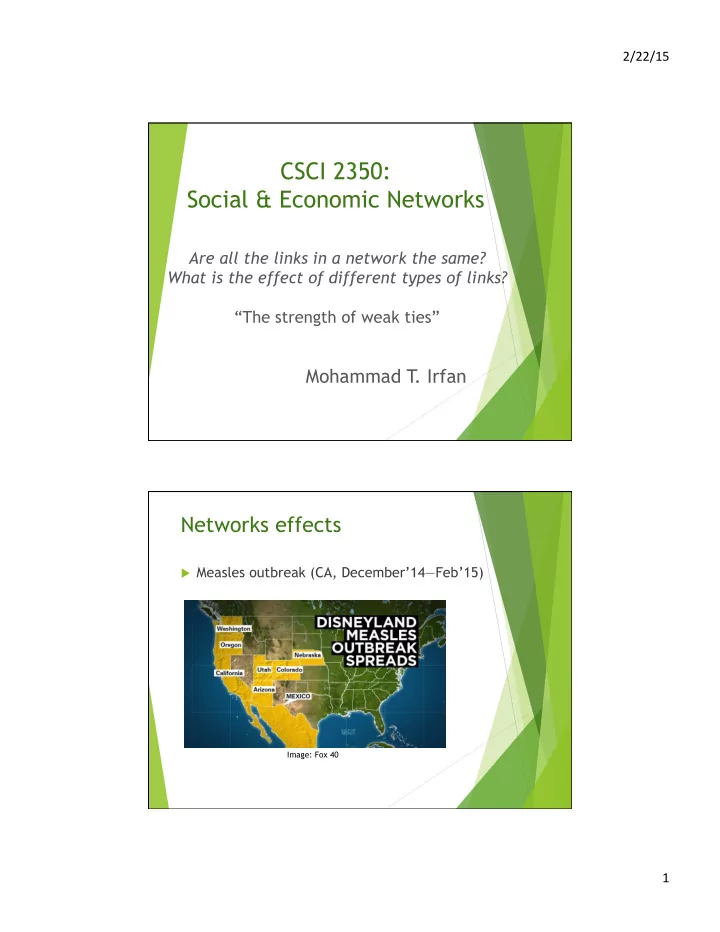

2/22/15 ¡ CSCI 2350: Social & Economic Networks Are all the links in a network the same? What is the effect of different types of links? “The strength of weak ties” Mohammad T . Irfan Networks effects u Measles outbreak (CA, December’14—Feb’15) Image: Fox 40 1 ¡
2/22/15 ¡ Granovetter’s study (1960s) u Acquaintances, not friends, hold critical information about job opportunities The strength of weak ties u Connect local/interpersonal properties to global/structural properties u Mathematically prove this local to global connection u Show that the “critical” ties are actually weak ties 2 ¡
2/22/15 ¡ Triadic closure B and C are very likely to become friends B C A Local bridge u An edge whose endpoints do not have a common friend ó An edge which is not a side of a triangle ó An edge whose deletion causes the distance between its endpoints to be > 2 Under some condition , every local bridge must be a weak tie 3 ¡
2/22/15 ¡ Big data (real-world) and the strength of weak ties Weak ties in Facebook (Marlow et al., 2009) Colleagues High school friends 4 ¡
2/22/15 ¡ Weak ties in Facebook (cont...) Weak ties (passive network) in FB facilitate newsfeed 5 ¡
2/22/15 ¡ Twitter (Huberman et al., 2009) Are weak ties really powerful? Gladwell: “weak ties seldom lead to high-risk activism” 6 ¡
2/22/15 ¡ Counter-argument Counter-argument 7 ¡
2/22/15 ¡ Counter-argument Community detection in social networks using local bridges Section 3.6 (Advanced) 8 ¡
2/22/15 ¡ Coauthorship network (Newman- Girvan, 2004) Idea u Delete local bridges one after another u Get connected components u close-knit communities u Divisive graph partitioning (as opposed to agglomerative) 9 ¡
2/22/15 ¡ But… which local bridge to delete first? Also… what if there’s no local bridge? Need some form of “betweenness” measure for the edges! 10 ¡
2/22/15 ¡ University ranking (unrelated to current topic) Eigenvector centrality http://www.wired.com/2015/02/academic-hiring-uphill-battle Solution: Girvan-Newman algorithm (2002) u Calculate the betweenness of each edge u Successively delete the edge(s) with the highest betweenness (and recalculate betweenness) 11 ¡
2/22/15 ¡ Betweenness of an edge u Every node is sending 1 gallon of water to every other node u Water will only flow through the shortest paths u Equally distributed among multiple shortest paths u Betweenness of an edge = Quantity of water flowing through it 12 ¡
2/22/15 ¡ How to compute the betweenness of an edge? Algorithm u A. For each node X do the following: Do BFS starting with X 1. Calculate the # of S.P . from X to every other node 2. Calculate the quantity of water flow through each edge 3. u B. Betweenness of an edge = sum of all water flow (over all the BFS) A B C D E F G H 13 ¡
2/22/15 ¡ BFS starting at node A A C D B E G F H Remember, BFS needs to be done starting at each node! # of S.P . from A to every node A 1 D 1 C B 1 This is the # of S.P . Formula: from A to G, not 2 E G 1 # of S.P . from A to E = distance from A to G Sum of the # of S.P . from A to each friend of E in the previous level 3 F H 3 14 ¡
2/22/15 ¡ Calculate water flow on each edge Node A has sent 1 gallon of water to every other node. Water flows only on S.P .– splits evenly on multiple S.P . A 1 C D B 1 1 1 2 E G 2/3 Why? gal. 1/3 gal. 3 F H 3 Calculate water flow on each edge Node A has sent 1 gallon of water to every other node. Water flows only on S.P .– splits evenly on multiple S.P . A 1 D 1 C B 1 2 E G 1 2/3 gal. 1/3 gal. 3 F H 3 15 ¡
2/22/15 ¡ Calculate water flow on each edge Node A has sent 1 gallon of water to every other node. Water flows only on S.P .– splits evenly on multiple S.P . A 13/6 1 gal. 23/6 gal. gal. 1 C D B 1 1 Why 7/6 gal. from D to E? 7/6 5/3 gal. 7/6 Ans. E consumes 1 gallon and gal. gal. passes 2/3 + 2/3 = 4/3 gallons 1 2 E G below it. So, E needs a supply 2/3 of 1 + 4/3 = 7/3 gallons, which 1/3 2/3 gal. is split evenly into two S.P . gal. gal. 1/3 from A to E. gal. 3 F H 3 We are not done yet! For each edge, we need to sum up the water flow from each BFS. Karate club (Zachary, 1977) 16 ¡
Recommend
More recommend